#african knifefish
Note
just learned about the electric eel's cooler (not) cousin, the African Knifefish (Gymnarchus niloticus). would be cool to see on in your style! c:

fish 188 - african knifefish/g. niloticus
169 notes
·
View notes
Text
Taxonomy Tournament: Fish
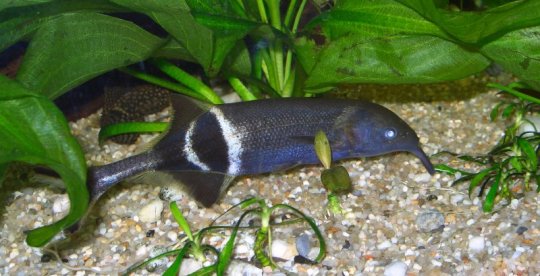

Osteoglossiformes. This order is made up of relatively primitive fish, which have bony tongues. Members include elephantfish and African knifefish.
Hiodontiformes. This order is made up of mooneyes, so called due to the shine of their large eyes
#animals#biology#polls#poll tournament#zoology#african knifefish#fish#mooneyes#Osteoglossiformes#Hiodontiformes#0x44v0xbb#animal tournament#Animal Tournament Round 1
57 notes
·
View notes
Text
i’ve been wondering for a while about mobility aids for merpeople, so here’s some ideas about that
-there are special webbed gloves designed to help people ‘pull’ themselves through water easier
-a waterproof wheelchair could be helpful for a merperson that spends all or most of the time on the [insert body of water here] floor
-propulsion devices
-a mix between a wheelchair and a propulsion device
-service animals (a setting featuring merpeople has lots of room for hippocampi/all their variants, sea serpents, giant versions of aquatic creatures, completely made up ones, etc.)
-modified crutches designed to stick to solid surfaces (because. underwater)
-winter the dolphin had a prosthetic tail that worked pretty well for her, though that isn’t too helpful for a character that doesn’t want or can’t use prosthetics
-carriage with a seatbelt or removable dome to keep the merperson safe inside, pulled along by some sort of creature (kind of dealer’s choice on that one)
-merperson with vision impairment could make use of, again, service animals. or they could use a device that functions similarly to electroreception in real fish (for an example, the african knifefish can swim just as easily backwards as it can forwards due to electroreception)
-waterproof braces
that’s all i have for now, offer some thoughts if you have any!
#also fun fact apparently most if not all fish hear via sensing vibrations in the water#something to think about
5 notes
·
View notes
Text
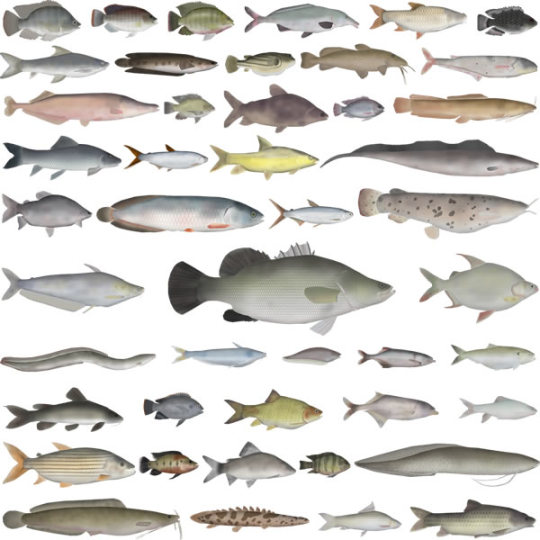
Nile River Basin Fish Group
Row 1: Nile Tilapia, Blue Tilapia, Redbreast Tilapia, Elephant Snout, True Big-Scale Tetra, Blue Spotted Tilapia
Row 2: Ningu, African Obsure Snakehead, Globe Fish, Giraffe Catfish, Ngai
Row 3: Cornish Jack, Mango Tilapia, Grass-eater, Singida Tilapia, North African Catfish
Row 4: African Carp, Silverides, Niger Barb, Aba
Row 5: Khraish, African Bonytongue, Characin, Electric Catfish
Row 6: Silver Catfish, Nile Perch, Moon Fish
Row 7: European Eel, Egyptian Butter Catfish, African Knifefish, Victoria Stonebasher, Twaite Shad
Row 8: Golden Nile Catfish, Victoria Tilapia, Labeobarbus surkis, Trunkfish, African Scraping Feeder
Row 9: Tiger Fish, Banded Jewelfish, Perch, Redbelly Tilapia, Marbled Lungfish
Row 10: North African Catfish, Saddled Bichir, Assuan Labeo, Ripon Barb
https://t.umblr.com/redirect?z=https%3A%2F%2Fwww.redbubble.com%2Fshop%2Fap%2F156144932&t=MWQ2MTVmNjA0ZDQ0N2UzMTUzYTJmNzk3ZTE4YjVhZDVjZDAyYmFiNCw3NzM1YTRiMjA4MDJkYzZmOTg0NTFhNDY3NjhkM2E0YWZiZTA5MDll&ts=1702664109
2 notes
·
View notes
Text
The Ancestors
Before divine selection could take place and the Tetrarch could begin, the deities had to choose what would inhabit their world. They would need to be adaptable enough to survive the ecological shock, and able to form a functional ecosystem from the beginning, but the rest was up to the deities’ own inscrutable choices. The majority of colonists were sourced from Earth’s Holocene epoch, but a handful of the founders were inexplicably from various other time periods. To allow more ecologically complex organisms to survive colonization, the cherry-picked settlers were introduced in successive waves, each supporting the next. The first assisted in the final steps of terraforming, the hardiest microbes starting or regulating such vital processes as oxygenation and the carbon cycle. Each wave that followed increased in size and diversity, until the Tetrarch’s founding menagerie was complete. This eclectic sample of Earth would give rise to every oddity making up the Tetrarch’s biosphere, the primordial ancestors from which all of its life descends. What follows is a list of these ancestors at the time that the Tetrarch was ready to begin, not including the myriad unicellular organisms and viruses whose descendants are also important.
Plants and Algae
-Brazilian Waterweed (Egeria densa)
-Coconut Palm (Cocos nucifera)
-Erect Prickly Pear (Opuntia stricta)
-Grasses (~ 5 species)
-Hooker’s Chives (Allium hookeri)
-Leptosporangiate Ferns (~ 5 species)
-Lithops (~ 5 species)
-Mosses (~ 5 species)
-Macroscopic Algae (~ 25 species, including Undaria and Acetabularia)
-Southern Magnolia (Magnolia grandiflora)
-Spanish Moss (Tillandsia usneoides)
-Turtlegrass (Thalassia testudinum)
Vertebrates
-African Clawed Frog (Xenopus laevis)
-Banded Knifefish (Gymnotus carapo)
-Conodonts (~ 5 species)
-Hapalops sp.
-Longspined Porcupinefish (Diodon holocanthus)
-Pacific Viperfish (Chauliodus macouni)
-Spiny Softshell Turtle (Apalone spinifera)
-Star-Nosed Mole (Condylura cristata)
Arthropods
-Atlantic Horseshoe Crab (Limulus polyphemus)
-Coccus Soft Scales (~ 5 species)
-Copepods (~ 25 species)
-Earwigs (~ 5 species)
-Goose Barnacles (~ 5 species)
-Hoverflies (~ 5 species)
-Lacewings (~ 5 species)
-Mites (~ 25 species)
-Pseudoscorpions (~ 5 species)
-Rainbow Mantis Shrimp (Pseudosquilla ciliata)
-Springtails (~ 15 species)
-Water Fleas (~ 5 species)
Molluscs
-Applesnails (~ 5 species)
-Hippurites sp.
-Sea Angels (~ 5 species)
-Sea Butterflies (~ 5 species)
-Venus Clams (~ 5 species)
Other Animals
-Arrow Worms (~ 5 species)
-Brittle Stars (~ 5 species)
-Clitellate Worms (~ 15 species, including leeches, earthworms, and naidids)
-Demosponges (~ 10 species)
-Dugesia Planarians (~ 5 species)
-Nematodes (~ 300 species)
-Rotifers (~ 5 species)
-Tardigrades (~ 5 species)
-Velvet Worms (~ 5 species)
Fungi
-Collared Earthstar (Geastrum triplex)
-Lichens (~ 5 species)
-Molds (~ 50 species)
#biology#fantasy#ecology#speculative biology#spec evo#spec bio#speculative evolution#the tetrarch#seed world#worldbuilding#artificial selection
6 notes
·
View notes
Text
The mighty clown knifefish
Asian knifefishes or featherbacks, relatives of the African mormyrid clade, are far less popular in aquaria, than are the unrelated knifefishes of South America. Knifefishes are not a natural descent group, but a morphotype, defined by the use of an elongated anal fin, to propel the fish by undulation, while its body is held still. This is very good for precision when swimming, but not for sustained speed. Old and New World knifefishes, also share the use of a "sixth sense" called electroception, that they use to navigate. Naturally, this too is an example of parallel evolution in action.
Chitala ornata, the clown knifefish, is a huge Asian knifefish from Indochina. It grows to 100 centimeters, or 40 inches, and is a known as a popular food fish in its native range. There, it inhabits the waters of large and medium sized rivers, also taking advantage of seasonal floodings, a behaviour that leads to them also occurring in pools and lakes. The rich presence of vegetation, or other natural cover, is important for this ambush predator of nocturnal habits. Rocks or wood provide them with somewhere on which to spawn.
Unfortunately, back in the days when C. ornata was more often exported for sale to aquarists in the past, and the species was a fairly common sight at aquarium retailers, a great many of these potential giants were not housed properly after sale. Being sold as novelties, at immature sizes and without information, to amateur fishkeepers who lacked prior knowledge. But now that the export of C. ornata has died down a lot, buyers are more likely to have better awareness as to the size and predatory habits of this powerful beast.
The clown knifefish is crepescular to nocturnal, so it prefers fairly dim lighting in the aquarium. Rocks or wood are necessary for their welfare, because this predator is instinctively drawn to them for its cover. As with other fishes from Indochinese rivers and their floodplains, C. ornata prefers a range of pH between 6 to 8. The appropriate temperture should be 24 to 28 degrees centigrade. The great size of these fishes, means its presence creates a lot of waste products, and strains the water quality in their aquarium. Biological filtration should therefore be very efficient, as is generally the case with 'predator fishes'.
At the small sizes at which they used to be sold most often, C. ornata are insectivores, and should be provided for as such in the aquarium. Larger C. ornata graduate with size, to take increasingly large prey in the wild, moving onto a diet based on smaller teleost fishes. In the aquarium too, the growing knifefish will similarly require carnivore-apt frozen and fishmongers foods. Most clown knifefishes will also consume proprietary dried foods, if they are suitable for carnivores.
C. ornata is pugnacious toward its own species, and those of similar appearance or habits. Only one individual of this species, should therefore be kept in an aquarium. Despite this, C. ornata and its kin, are usually fine cohabiting with dissimilar species, provided the aquarium or pond is large enough, and the cohabitants will not be seen as potential prey. Which is to say, cohabiting fish should be at least 1/3 the size of the mighty knifefish.
0 notes
Text
Fish with electrogenesis usually produce electric charges through electrocytes or electroplaques—typically flat, disc-like modified muscle or nerve cells all stacked together. In marine fish, these cells are connected like batteries in a parallel circuit, whereas in freshwater fish they are connected like batteries in series. These latter fish are capable of producing discharges of higher voltage, because fresh water doesn’t conduct electricity as well as salt water. Each cell in the battery can produce nearly 0.15 volts by pumping out positive sodium and potassium ions. The electric eel has around 5,000 or 6,000 electroplaques in its abdomen, allowing it to generate shocks as strong as 600 volts to stun its prey. It also can lower its voltage pulses to around 10 volts to navigate and to detect prey. As a result of its electrogenerative abilities, the electric eel is found only in freshwater habitats, as salt water can have the unhelpful effect of causing the fish to naturally short-circuit. The electric ray, which has no such problem, has a pair of special kidney-shaped organs at the base of the pectoral fins that generate and store electricity and send out charges from 8 to 220 volts to electrocute prey or to stun a possible predator.
Electric catfish, common in African fresh waters, generate their electrical discharges from their skin rather than from electric organs that consist of individual electroplacques. When a foraging torpedo ray detects prey it swims forward and upward, exposing its ventral surface toward the fish while emitting low-frequency voltage pulses. The currents passing through the victim’s body excite its nerves and muscles, stunning it and immobilizing it, whereupon the torpedo descends over it and consumes it while continuing to emit pulses. Large Atlantic torpedo rays can generate enough power to produce a shock of up to 220 volts ; that’s enough voltage to run a household appliance, such as a blender or a clothes dryer.
Weakly electric fish, like the elephantnose fish, use their electrogenerative ability either to navigate, or locate prey, or to communicate. Instead of the electroplaques as in the electric eel, they have electric organs consisting of columns of electrocytes that generate relatively feeble electric fields. This type of active electrolocation relies on the ability of the elephantnose fish and other species that use it to detect any distortions in an electric field of less than 1 volt.
Although it’s not well understood how the brain extracts all of the sensory information for active electroreception, the sensors (also called electroreceptors) in the skin are sensitive to the rate of change of voltage across their cell membrane. In contrast, sharks and rays as well as most species of catfish use passive electroreception where the animal senses the weak bioelectric fields generated by other animals.
Sharks are the most electrically sensitive animals known; they respond to non-alternating current (DC) fields as low as 5 nanovolts per centimeter and can use this ability to detect a small fish buried in the sand.
Among groups of knifefish, the strongest adult male lets his presence be known by sending out the highest rate of electrical discharge—900 pulses per second. The rest of the males have lower frequency rates and are careful not to interfere with the frequencies of others. However, when a rival wants to challenge the dominant male, the challenger also will generate pulses at a frequency of 900 hertz to jam the signal. In response, the dominant male might zap his rival with a higher frequency charge of up to 1,000 hertz. But if the rival male continues to challenge and jam, the two males will probably fight it out physically, sometimes ending up locked jaw-to-jaw for an entire night.
0 notes
Photo
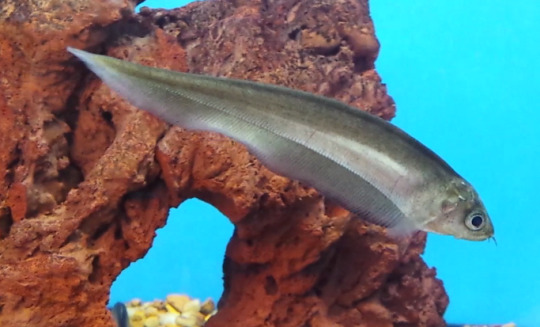
Of all the available Knifefish species in the trade, the Brown Knifefish is probably your best bet. Not as sensitive as the Ghost Knifefish and stays smaller to boot.
20 notes
·
View notes
Link
As we know that aquariums can easily steal your heart and become the epitome of more beauty at home. So, if you want to Buy African Knifefish Online, you can visit our official website. However, you can read our blog for official information.
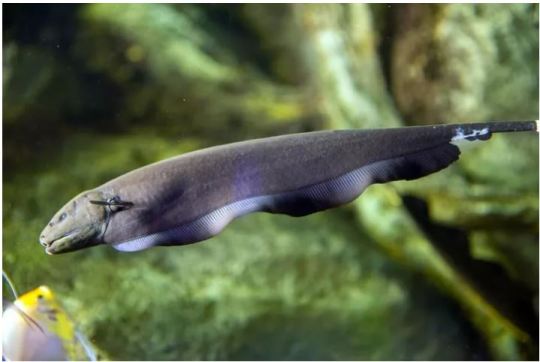
0 notes
Photo

The full book title contains 3777 words and reads as follows: 'The historical development of the Heart i.e. from its formation from Annelida: Clam worm, Seamouse, Lugworm, Megascolex, Tubifex, Pheretima, Freshwater leech, marine leech, land leech. Arthropoda: Ladybird, Krill, Rock Barnacle, Root-headed Barnacle, Copepod, Silverfish, Cairns birdwing, Silver - spotted skipper, Scutigera, Cray fish, Large white, Andonis blue, Camberwell beauty, Tiger swallowtail, Regent skipper, Black – veined white, Green – underside blue, Blue Morpho, Apollo, Guava skipper, Cleopatra, Large copper, Millipede, Orb spider, Black widow spider, Giant crab spider, Wolf spider, Bird – eating spider, Tenebrionid beetle, Green Tiger beetle, African goliath beetle, Scolopendra, Diving beetle, African ground beetle, New guinea weevil, Barnacle, Lobster, Shrimp, Woodlice, Mite, Prawn, Housefly, Butterfly, Monarch butterfly, Peacock butterfly, Honey bee, Fairy shrimp, Horsehoe crab, Tick, Bluebootle, Froghopper, Yellow crazy ant, Water flea, Sea spider, Fiddler crab, Shiny spider crab, Hermit crab, Sail swallowtail, Red admiral, Morpho butterfly, Desert locust, Stephens island weta, Speckled bush cricket, Mole cricket, Dung – beetle, Euthalia ynipardus, Small blues, Termite, Hornet, Mosquito, Garden spider, Tarantula, Desert hairy scorpion, Emperor dragon – fly, Moth, Centipede, Wood ant, Stag beetle, Indian red admiral, Blue admiral, Harvestman, Hoverfly, Shield bug, Assassin bug, Cicada, Coreid bug, Rose aphid, Water – boatman, Wasp, June bug, Large tortoiseshell, Frog beetle, Mexican red – legged tarantula, Paintedlady, Sydney funnelweb spider, Small tortoiseshell, Mountain bumble bee, Trapdoor spider, Jumping spider, Daddy longlegs spider, Orchind bee, Asian carpenter bee, Parasitic bee, House spider, Giant longhorn beetle, Flea, Bedbug Beetle, Cockroach, Scorpion, Spider, Ant, Gnats, Grasshopper, Silver fish, Crab, Great green bush cricket, Elephant hawk – moth. Mollusca: Neomenia, Chaetoderma, Chiton, Lepidopleurus, Apple snail, Sea hare, Sea lemon, Dentalium, Freshwater mussel, Marine mussel, Pearl oyster, Cuttlefish, Giant squid, Chambered fish, Devilfish. Fishes or Pisces: African glass catfish, African lungfish, Aholehole, Airbreathing catfish, Alaska blackfish, Albacore, Alewife, Alfonsino, Algae eater, Alligatorfish, Alligator gar, Amberjack - Seriola dumerili, American sole, Amur pike, Anchovy, Anemonefish, Angelfish, Angler, Angler catfish, Anglerfish, Antarctic cod, Antarctic icefish, Antenna codlet, Arapaima, Archerfish, Arctic char, Armored gurnard, Armored searobin, Armorhead, Armorhead catfish, Armoured catfish, Arowana, Arrowtooth eel, Asian carps, Asiatic glassfish, Atka mackerel, Atlantic Bonito (Sarda sarda), Atlantic cod, Atlantic herring, Atlantic salmon, Atlantic Sharpnose Shark - Rhizoprioltodon terraenovae, Atlantic saury, Atlantic silverside, Australasian salmon, Australian grayling, Australian herring, Australian lungfish, Australian prowfish, Ayu, Baikal oilfish, Bala shark, Ballan wrasse, Bamboo shark, Banded killifish, Bandfish, Banjo, Bangus, Banjo catfish, Bank Sea Bass, Barb, Barbel, Barbeled dragonfish, Barbeled houndshark, Barbel-less catfish, Barfish, Barracuda, Barracudina, Barramundi, Barred danio, Barreleye, Basking shark, Bass, Basslet, Batfish, Bat ray, Beachsalmon, Beaked salmon, Beaked sandfish, Beardfish, Beluga sturgeon, Bengal danio, Betta, Bichir, Bicolor goat fish, Bigeye, , Bighead carp, Bigmouth buffalo, Bigscale, Billfish, Bitterling, Black angelfish, Black bass, Black dragonfish, Blackchin, Blackfin Tuna - Thunnus atlanticus, Blackfish, Black neon tetra, Blacktip reef shark, Black mackerel, Black scalyfin, Black sea bass, Black scabbardfish, Black swallower, Black tetra, Black triggerfish, Bank Sea Bass aka Yellow Sea Bass - Centropristis ocyurus, Bleak, Blenny, Blind goby, Blind shark, Blobfish, Blueline Tilefish, Blowfish, Blue catfish, Blue danio, Blue-redstripe danio, Blueline Tilefish , Blue eye, Bluefin tuna, Bluefish, Bluegill, Blue gourami, Blue shark, Blue triggerfish, Blue whiting, Bluntnose knifefish, Bluntnose minnow, Boafish, Boarfish, Bobtail snipe eel, Bocaccio, Boga, Bombay duck, Bonefish, Bonito, Bonnetmouth, Bonytail chub, Bronze corydoras, Bonytongue, Bowfin, Boxfish, Bramble shark, Bream, Brill, Bristlemouth, Bristlenose catfish, Broadband dogfish, Brook lamprey, Brook trout, Brotula, Brown trout, Buffalo fish, Bullhead, Bullhead shark, Bull shark, Bull trout, Burbot, Bumblebee goby, Buri, Burma danio, Burrowing goby, Butterfish, Butterfly ray, Butterflyfish, California flyingfish, California halibut, Canary rockfish, Candiru, Candlefish, Capelin, Cardinalfish, Cardinal tetra, Carp, Carpetshark, Carpsucker, Catalufa, Catfish, Catla, Cat shark, Cavefish, Celebes rainbowfish, Central mudminnow, Chain pickerel, Channel bass, Channel catfish, Char, Cherry salmon, Chimaera, Chinook salmon, Cherubfish, Chub, Chubsucker, Chum salmon, Cichlid, Cisco, Climbing catfish, Climbing gourami, Climbing perch, Clingfish, Clownfish, Clown loach, Clown triggerfish, Cobbler, Cobia, Cod, Codlet, Codling, Coelacanth, Coffinfish, Coho salmon, Coley, Collared carpetshark, Collared dogfish, Colorado squawfish, Combfish, Combtail gourami, Common carp, Common tunny, Conger eel, Convict blenny, Convict cichlid, Cookie-cutter shark, Coolie loach, Cornetfish, Cowfish, Cownose ray, Cow shark, Crappie, Creek chub, Crestfish, Crevice kelpfish, Croaker, Crocodile icefish, Crocodile shark, Crucian carp, Cuckoo wrasse, Cusk, Cusk-eel, Cutlassfish, Cutthroat eel, Cutthroat trout, Dab, Dace, Desert pupfish, Devario, Devil ray, Dhufish, Discus, Diver: New Zealand sand diver or long-finned sand diver, Dogfish, Dogfish shark, Dogteeth tetra, Dojo loach, Dolly Varden trout, Dolphin fish - Corypaena hippurus, Dorab, Dorado, Dory, Dottyback, Dragonet, Dragonfish, Dragon goby, Driftfish, Driftwood catfish, Drum, Duckbill, Duckbill eel, Dusky grouper, Dusky Shark - Carcharhinus obscurus, Dwarf gourami, Dwarf loach, Eagle ray, Earthworm eel, Eel, Eel cod, Eel-goby, Eelpout, Eeltail catfish, Elasmobranch, Electric catfish, Electric eel, Electric knifefish, Electric ray, Elephant fish, Elephantnose fish, Elver, Ember parrotfish, Emerald catfish, Emperor angelfish, Emperor bream, Escolar, Eucla cod, Eulachon, European chub, European eel, European flounder, European minnow, European perch, False brotula, False cat shark, False moray, Fangtooth, Fathead sculpin, Featherback, Fierasfer, Fire goby, Filefish, Finback cat shark, Fingerfish, Firefish, Flabby whale fish, Flagblenny, Flagfin, Flagfish, Flagtail, Flashlight fish, Flatfish, Flathead, Flathead catfish, Flier, Flounder, Flying gurnard, Flying fish, Footballfish, Forehead brooder, Four-eyed fish, French angelfish, Freshwater eel, Freshwater hatchetfish, Freshwater shark, Frigate mackerel, Frilled shark, Frogfish, Frogmouth catfish, Fusilier fish, Galjoen fis, Ganges shark, Geel, Garibaldi, Garpike, Ghost fish, Ghost flathead, Ghost knifefish, Ghost pipefish, Ghost shark, Ghoul, Giant danio, Giant gourami, Giant sea bass, Gibberfish, Gila trout, Gizzard shad, Glass catfish, Glassfish, Glass knifefish, Glowlight danio, Goatfish, Goblin shark, Goby, Golden dojo, Golden loach, Golden shiner, Golden trout, Goldeye, Goldfish, Gombessa, Goosefish, Gopher rockfish, Gourami, Grass carp, Graveldiver, Grayling, Gray mullet, Gray reef shark, Great white shark, Green swordtail, Greeneye, Greenling, Grenadier, Green spotted puffer, Ground shark, Grouper, Grunion, Grunt, Grunter, Grunt sculpin, Gudgeon, Guitarfish, Gulf menhaden, Gulper eel, Gulper, Gunnel, Guppy, Gurnard, Haddock, Hagfish, Hairtail, Hake, Halfbeak, Halfmoon, Halibut, Halosaur, Hamlet, Hammerhead shark, Hammerjaw, Handfish, Hardhead catfish, Harelip sucker, Hatchetfish, Hawkfish, Herring, Herring smelt, Hickory Shad, Horn shark, Horsefish, Houndshark, Huchen, Humuhumunukunukuapua'a, Hussar, Icefish, Ide, Ilisha, Inanga, Inconnu, Jack, Jackfish, Jack Dempsey, Japanese eel, Javelin, Jawfish, Jellynose fish, Jewelfish, Jewel tetra, Jewfish, John Dory, Kafue pike, Kahawai, Kaluga, Kanyu, Kelp perch, Kelpfish, Killifish, King of the herrings, Kingfish, King-of-the-salmon, Kissing gourami, Knifefish, Knifejaw, Koi, Kokanee, Kokopu, Kuhli loach, Labyrinth fish, Ladyfish, Lake chub, Lake trout, Lake whitefish, Lampfish, Lamprey, Lanternfish, Largemouth bass, Leaffish, Lefteye flounder, Lemon shark, Lemon sole, Lemon tetra, Lenok, Leopard danio, Lightfish, Limia, Lined sole, Ling, Ling cod, Lionfish, Livebearer, Lizardfish, Loach, Loach catfish, Loach goby, Loach minnow, Longfin, Longfin dragonfish, Longfin escolar, Longfin smelt, Long-finned char, Long-finned pike, Longjaw mudsucker, Longneck eel, Longnose chimaera, Longnose dace, Longnose lancetfish, Longnose sucker, Longnose whiptail catfish, Long-whiskered catfish, Loosejaw, Lost River sucker, Louvar, Loweye catfish, Luderick, Luminous hake, Lumpsucker, Lungfish, Mackerel, Mackerel shark, Madtom, Mahi-mahi, Mahseer, Mail-cheeked fish, Mako shark, Mandarinfish, Masu salmon, Medaka, Medusafish, Megamouth shark, Menhaden, Merluccid hake, Mexican golden trout, Midshipman fish, Milkfish,, Minnow, Minnow of the deep, Modoc sucker, Mojarra, Mola, Monkeyface prickleback, Monkfish, Mooneye, Moonfish, Moorish idol, Mora, Moray eel, Morid cod, Morwong, Moses sole, Mosquitofish, Mouthbrooder, Mozambique tilapia, Mrigal, Mud catfish (Mud cat), Mudfish, Mudminnow, Mud minnow, Mudskipper, Mudsucker, Mullet, Mummichog, Murray cod, Muskellunge, Mustache triggerfish, Mustard eel, Naked-back knifefish, Nase, Needlefish, Neon tetra, New World rivuline, New Zealand smelt, Nibble fish, Noodlefish, North American darter, North American freshwater catfish, North Pacific daggertooth, Northern anchovy, Northern clingfish, Northern lampfish, Northern pike, Northern sea robin, Northern squawfish, Northern stargazer, Notothen, Nurseryfish, Nurse shark, Oarfish, Ocean perch, Ocean sunfish, Oceanic whitetip shark, Oilfish, Oldwife, Old World knifefish, Olive flounder, Opah, Opaleye, Orange roughy, Orangespine unicorn fish, Orangestriped triggerfish, Orbicular batfish, Orbicular velvetfish, Oregon chub, Orfe, Oriental loach, Oscar, Owens pupfish, Pacific albacore, Pacific cod, Pacific hake, Pacific herring, Pacific lamprey, Pacific salmo, Pacific saury, Pacific trout, Pacific viperfish, Paddlefish, Pancake batfish, Panga, Paradise fish, Parasitic catfish, Parore, Parrotfish, Peacock flounder, Peamouth, Pearleye, Pearlfish, Pearl danio, Pearl perch, Pelagic cod, Pelican eel, Pelican gulper, Pencil catfish, Pencilfish, Pencilsmelt, Peppered corydoras, Perch, Peters' elephantnose fish, Pickerel, Pigfish, Pike conger, Pike eel, Pike, Pikeblenny, Pikeperch, Pilchard, Pilot fish, Pineapplefish, Pineconefish, Pink salmon, Píntano, Pipefish, Piranha, Pirarucu, Pirate perch, Plaice, Platy, Platyfish, Pleco, Plownose chimaera, Poacher, Pollock, Pomfret, Pompano dolphinfish, Ponyfish, Popeye catalufa, Porbeagle shark, Porcupinefish, Porgy, Port Jackson shark, Powen, Prickleback, Pricklefish, Prickly shark, Prowfish, Pufferfish, Pumpkinseed, Pupfish, Pygmy sunfish, Queen danio, Queen parrotfish, Queen triggerfish, Quillback, Quillfish, Rabbitfish, Raccoon butterfly fish, Ragfish, Rainbow trout, Rainbowfish, Rasbora, Ratfish, Rattail, Ray, Razorback sucker, Razorfish, Red Grouper, Red salmon, Red snapper, Redfin perch, Redfish, Redhorse sucker, Redlip blenny, Redmouth whalefish, Redtooth triggerfish, Red velvetfish, Red whalefish, Reedfish, Reef triggerfish, Remora, Requiem shark, Ribbon eel, Ribbon sawtail fish, Ribbonfish, Rice eel, Ricefish, Ridgehead, Riffle dace, Righteye flounder, Rio Grande perch, River loach, River shark, River stingray, Rivuline, Roach, Roanoke bass, Rock bass, Rock beauty, Rock cod, Rocket danio, Rockfish, Rockling, Rockweed gunnel, Rohu, Ronquil, Roosterfish, Ropefish, Rough scad, Rough sculpin, Roughy, Roundhead, Round herring, Round stingray, Round whitefish, Rudd, Rudderfish, Ruffe, Russian sturgeon, Sábalo, Sabertooth, Saber-toothed blenny, Sabertooth fish, Sablefish, Sacramento blackfish, Sacramento splittail, Sailfin silverside, Sailfish, Salamanderfish, Salmon, Salmon shark, Sandbar shark, Sandburrower, Sand dab, Sand diver, Sand eel, Sandfish, Sand goby, Sand knifefish, Sand lance, Sandperch, Sandroller, Sand stargazer, Sand tiger, Sand tilefish, Sandbar Shark - Carchathinus plumbeus, Sarcastic fringehead, Sardine, Sargassum fish, Sauger, Saury, Sawfishm, Saw shark, Sawtooth eel, Scabbard fish, Scaly dragonfish, Scat, Scissortail rasbora, Scorpionfish, Sculpin, Scup, Sea bass, Sea bream, Sea catfish, Sea chub, Sea devil, Sea dragon, Sea lamprey, Sea raven, Sea snail, Sea toad, Seahorse, Seamoth, Searobin, Sevan trout, Sergeant major, Shad, Shark, Sharksucker, Sharpnose puffer, Sheatfish, Sheepshead, Sheepshead minnow, Shiner, Shortnose chimaera, Shortnose sucker, Shovelnose sturgeon, Shrimpfish, Siamese fighting fish, Sillago, Silver carp, Silver dollar, Silver dory, Silver hake, Silverside, Silvertip tetra, Sind danio, Sixgill ray, Sixgill shark, Skate, Skilfish, Skipjack tuna, Slender mola, Slender snipe eel, Sleeper, Sleeper shark, Slickhead, Slimehead, Slimy mackerel, Slimy sculpin, Slipmouth, Smalleye squaretail, Smalltooth sawfish, Smelt, Smelt-whiting, Smooth dogfish, Snailfish, Snake eel, Snakehead, Snake mackerel, Snapper, Snipe eel, Snipefish, Snoek, Snook, Snubnose eel, Snubnose parasitic eel, Sockeye salmon, Soldierfish, Sole, South American darter, South American lungfish, Southern Dolly Varden, Southern flounder, Southern hake, Southern sandfish, Southern smelt, Spadefish, Spaghetti eel, Spanish mackerel, Spearfish, Speckled trout, Spiderfish, Spikefish, Spinefoot, Spiny basslet, Spiny dogfish, Spiny dwarf catfish, Spiny eel, Spinyfin, Splitfin, Spookfish, Spotted climbing perch, Spotted danio, Spottail Pinfish - Diplodus holbrooki, Sprat, Springfish, Squarehead catfish, Squaretail, Squawfish, Squeaker, Squirrelfish, Staghorn sculpin, Stargazer, Starry flounder, Steelhead, Stickleback, Stingfish, Stingray, Stonecat, Stonefish, Stoneroller minnow, Stream catfish, Striped bass, Striped burrfish, Sturgeon, Sucker, Suckermouth armored catfish, Summer flounder, Sundaland noodlefish,Sunfish, Surf sardine, Surfperch, Surgeonfish, Swallower, Swamp-eel, Swampfish, Sweeper, Swordfish, Swordtail, Tadpole cod, Tadpole fish, Tailor, Taimen, Tang, Tapetail, Tarpon, Tarwhine, Telescopefish, Temperate bass, Temperate perch, Tenpounder, Tenuis, Tetra, Thorny catfish, Thornfish, Threadfin, Threadfin bream, Thread-tail, Three spot gourami, Threespine stickleback, Three-toothed puffer, Thresher shark, Tidewater goby, Tiger barb, Tigerperch, Tiger shark, Tiger shovelnose catfish, Tilapia, Tilefish, Titan triggerfish, Toadfish, Tommy ruff, Tompot blenny, Tonguefish, Tope, Topminnow, Torpedo, Torrent catfish, Torrent fish, Trahira, Treefish, Trevally, Triggerfish, Triplefin blenny, Triplespine, Tripletail, Tripod fish, Trout, Trout cod, Trout-perch, Trumpeter, Trumpetfish, Trunkfish, Tubeblenny, Tube-eye, Tube-snout, Tubeshoulder, Tui chub, Tuna, Turbot, Two spotted goby, Uaru, Unicorn fish, Upside-down catfish, Vanjaram, Velvet belly lanternshark, Velvet catfish, Velvetfish, Vermillion Snapper - Rhomboplites aurorubens, Vimba, Viperfish, Wahoo, Walking catfish, Wallago, Walleye, Walleye Pollock, Walu, Warmouth, Warty angler, Waryfish, Waspfish, Weasel shark, Weatherfish, Weever, Weeverfish, Wels catfish, Whale catfish, Whalefish, Whale shark, Whiff, Whitebait, White croaker, Whitefish, White marlin, White shark, Whitetip reef shark, Whiting, Wobbegong, Wolf-eel, Wolffish, Wolf-herring, Worm eel, Wormfish, Wrasse, Wrymouth, X-ray fish, Yellowback fusilier, Yellowbanded perch, Yellow bass, Yellowedge grouper (Hyporthodus flavolimbatus), Yellow-edged moray, Yellow-eye mullet, Yellowhead jawfish, Yellowfin croaker, Yellowfin cutthroat trout, Yellowfin grouper, Yellowfin Tuna - Thunnus albacares, Yellowfin pike, Yellowfin surgeonfish, Yellowfin tuna, Yellowmargin triggerfish, Yellow moray, Yellow perch, Yellowtail, Yellowtail amberjack, Yellowtail barracuda, Yellowtail clownfish, Yellowtail horse mackerel, Yellowtail kingfish, Yellowtail snapper, Yellow tang, Yellow weaver, Yellowtail catfish, Zander, Zebra bullhead shark, Zebra danio, Zebrafish, Zebra lionfish, Zebra loach, Zebra oto, Zebra pleco, Zebra shark, Zebra tilapia, Zebra turkeyfish, Ziege, Zingel. Amphibians: Frogs and Toads, Painted frogs, Disc tongued frogs, Fire Belly toads, Litter frogs, European Spadefoot toads, Parsley frogs, Tongueless frogs, Clawed frogs, Mexican Burrowing Toad, American spadefoot toads, Screeching frogs, True toads, Glass Frogs, Poison dart frogs, Ghost frogs, Shovelnose frogs, Tree frogs, Sedge frogs, Southern frogs, Narrow-mouthed frogs, Australian ground frogs, True frogs, Moss frogs, Seychelles frog, Giant Salamanders, Asiatic Salamanders, Mole Salamanders, Pacific giant salamanders, Amphiumas, Lungless salamanders, Mudpuppies and Waterdogs, Torrent salamanders, True salamanders and Newts, Sirens, Common caecilians, Fish caecilians, Beaked caecilians. Reptiles: Turtles, common snapping turtles and alligator snapping turtle, pond turtles and box turtles, tortoises, Asian river turtles and allies, pignose turtles, softshell turtles, river turtles, mud turtles, sea turtles, leatherback turtles, tuataras, scaled reptiles, agamas, chameleons, casquehead lizard, iguanas, Madagascar iguanids, collared and leopard lizards, horned lizards, anoles, wood lizards, Neotropical ground lizards, geckos, legless lizards, blind lizards, spinytail Lizards, plated lizards, spectacled lizards, whiptails and tegus, Lacertids, skinks, night lizards, glass lizards, American legless lizards, knob-scaled lizards, gila monsters, earless Monitor lizards, monitor lizards, worm Lizards, shorthead Worm Lizards, two-legged Worm Lizards, snakes, wart snakes, false coral snakes, dwarf pipe snakes, African burrowing asps, stiletto snakes, boas, anacondas, Old World sand boas, Mauritius snakes, Colubrids, typical snakes, Asian pipe snakes, cobras, coral snakes, mambas, sea snakes, Mexican pythons, pythons, dwarf boas, pipe snakes, shield-tailed snakes, vipers, pitvipers, Fae's viper, night adders, pitvipers, rattlesnakes, true vipers, sunbeam snakes, blind snakes, primitive blind snakes, slender blind snakes, thread snakes, blind snakes, typical blind snakes, Crocodiles, alligators, garials. Aves: Ostrich, rheas, cassowaries and emu, kiwis, elephant birds, upland moas, great moas, lesser moas, Tinamous, Australian brush turkey,megapodes, chachalacas, curassows, and guans, Guineafowl, pheasants and allies, New World quail, pheasants and relatives, mihirungs, screamers, magpie-goose, ducks, geese, and swans, grebes, swimming flamingos, flamingos, pigeons and doves, sandgrouse, mesites, Tawny frogmouth, Nightjars, oilbird, potoos, frogmouths, owlet-nightjars, treeswifts, swifts, hummingbird, cuckoos and relatives, turacos and relatives, bustards, hoatzin, cranes and allies, cranes, limpkin, trumpeters, rails and allies, adzebills, finfoots, flufftails, rails and relatives, thick-knees and allies, thick-knees and relatives, sheathbills, Magellanic plover, plover-like waders, golden plovers, ibisbill, oystercatchers, plovers and lapwings, jacana-like waders, painted snipes, Egyptian plover, jacanas, seedsnipes, plains-wanderer, sandpipers and relatives, buttonquail, gulls and allies, coursers and pratincoles, crab-plover, skuas and jaegers, auks and puffins, gulls, skimmers and terns, sunbittern, tropicbirds, penguins, albatrosses, austral storm petrels, northern storm petrels, petrels and relatives, White stork, storks, frigatebirds, boobies and gannets, darters, cormorants and shags, ibises and spoonbills, hamerkop, shoebill, pelicans, herons and relatives, New World vultures, secretarybird, osprey, hawks, eagles, buzzards, harriers, kites and Old World vultures, barn owls, true owls, mousebirds, cuckooroller, trogons and quetzals, hornbills, hoopoe, woodhoopoes, bee-eater, rollers, ground rollers, todies, motmots, Kingfisher, jacamars, puffbirds, African barbets, Asian barbets, toucans, toucan barbets, American barbets, woodpeckers, honeyguides, seriemas, falcons and relatives, kakapo, kea and kakas, cockatoos, African and American parrots, Australasian parrots, Pesquet's parrot, vasa parrots, Pitta cyanea, Lyrebird, New Zealand wrens, suboscines, Old World suboscines, sapayoa, Calyptomenid broadbills, pittas, broadbills, asities, New World suboscines, bronchophones, manakins, cotingas, sharpbills, royal flycatchers and allies, becards and tityras, spadebills, many-colored rush tyrants, mionectine flycatchers, tyrant flycatchers, tracheophones, crescent-chests, gnateaters, antbirds, antpittas, ground antbirds, ovenbirds, oscines, scrub-birds, lyrebirds, bowerbirds, Australasian treecreepers, Australasian wrens, bristlebirds, gerygones and allies, honeyeaters and relatives, Australasian babblers, logrunners, quail-thrushes and jewel-babblers, cuckoo-shrikes, whitehead and allies, sittellas, wattled ploughbills, whipbirds and quail-thrushes, Australo-Papuan bellbirds, crested shriketits, painted berrypeckers, vireos and relatives, whistlers and relatives, Old World orioles, Boatbills, woodswallows and butcherbirds, mottled berryhunter, ioras, bristlehead, bushshrikes and relatives, wattle-eyes and batises, vangas , fantails, silktail, drongo fantail, drongos, blue-capped ifrits, Australian mudnesters, birds-of-paradise, monarch flycatchers, shrikes, jays and crows, berrypeckers, satinbirds, Australasian robins, stitchbird, wattlebirds, rockfowl, rock-jumpers, rail-babbler, fairy warblers, hyliotas, penduline tits, chickadees and true tits, Nicators, bearded reedling, larks, African warblers, cisticolas and relatives, marsh warblers, pygmy wren-babblers, grass warblers, Malagasy warblers, swallows and martins, bulbuls, leaf warblers, bush warblers , Bushtits, true warblers, parrotbills, fulvettas, white-eyes, babblers and relatives, fulvettas, ground babblers, laughing thrushes, kinglets, spotted wren-babblers, Hawaiian honeyeaters, silky-flycatchers, waxwings, Palmchat, hypocolius, wallcreeper, nuthatches, treecreepers, wrens, gnatcatchers, dippers, thrushes and relatives, flycatchers and relatives, oxpeckers, mockingbirds and thrashers, starlings and mynas , sugarbirds, dapplethroat and allies, flowerpeckers, sunbirds, fairy-bluebirds, leafbirds, olive warbler, accentors, pink-tailed bunting, weavers and relatives, whydahs and indigobirds, weaver finches, Old World sparrows, wagtails and pipits, finches and relatives, longspurs, snow buntings, rosy thrush-tanagers, Old World buntings and New World sparrows, American sparrows, palm-tanager and allies, New World blackbirds and New World orioles, Cuban warblers, wood warblers, cardinals, grosbeaks, and New World buntings, tanagers and relatives. MAMMALS: Rat, Bat, Horse, Standardbred, Throughbred, Saddlebred, Arab, Palomino, Australian stock, Appaloosa, Barb, Lippizaner, Mustang, American Shetland, Falabella, Percheron, Shire, Mule, Bullock, Setter, Oxen, Camel, Tiger, Lion, Hyaenas, Leopard, Bear, Cat, Dog, Sheep, Goat, Cow, Cob, Pig, Chamois, Bulldog, Borzoi, Loris, Longspur, Harvest mouse, Spiny – ant eater, Duck – billed platypus, Elephant, Rhinoceros, Tonkinese, Ragdoll, Margay, Tapir, Seal, Sea lion, Walrus, Dolphin, Bactrian camel, Arabian camel, Bushbaby, Burmese cat, Whale, Porpoise, Aardvark, Ape, Monkey, Gorilla, Chimpanzee, Flying Lemur, Hare, Pika, Macaque, Rabbit, Colobus, Antelope, Caribou, Cattle, Deer, Grizzly bear, Hyrax, Armadillo, Porcupine, Hedgehog, Arctic hare, Mole, Shrew, Beaver, Asian black bear, Polar bear, Sloth bear, Spectacled bear, Mouse, Squirrel, Dugong, Moose, Fallow deer, Reindeer, Red deer, Manatee, Egyptian Mau, Scottish fold, Himalayan, Birman, Red squirrel, Hippopotamus, Weasel, Whale, Wither, Blue whale, Sperm whale, Killer whale, Wallaby, Beluga, Baird’s beaked whale, Grey whale, Bryde’s whale, Pygmy right whale, Southern right whale, Seal, Ape, Indri, Aye – aye, Alaskan Malamute, Dobermann, Beagle, Kinkajou, Afgan Hound, Rough Collie, Cardigan Welsh Corgi, Sheepdog, Pointer, Poddle, Weimaraner, Bloodhound, Zebra, Giraffe, Yak, Arctic fox, Polecat, Golden Retriever, Kerry Blue, Prairie dog, Airedale, German spitz, Pekingese, Otter, Shih Tzu, Proboscis monkey, Orang – utan, Red Howler monkey, Spider monkey, Sloth, Koala, Pangolin, Mustelid, Mongoose, Guinea pig, Malayan Porcupine, Naked Mole rat, Capybara, Pallid Gerbil, Brown rat, Somali, Ocicat, Balinese, Bengal, Cymric, Chartreux, Devon Rex, Turkish Angora, Russian Blue, Yellow – necked woodmouse, Hamster, Grey squirrel, Chipmunk, Fox, Blue Longhair, Chinese Pangolin, Blue – cream shorthair, Tortoiseshell and white shorthair, Brown spotted shorthair, Red and white Japanese bobtail, Javanese, Red Persian Longhair, Brown classic tabby maine coon, Lilac angora, Seal point Siamese, Brown and white sphinx, Red classic tabby manx, Vampire bat, Proboscis bat, Franquet’s fruit bat, Bengal Tiger, Horseshoe bat, Noctule bat, Funnel - eared bat, Blue exotic, Foreign lilac oriental shorthair, Boxer, Bay, Cream point colour pointed british shorthair, Abyssinian, Cinnamon silver Cornish rex, Wolverine, Skunk, Human being, Pine marten, Stoat, Chocolate point longhair, Husky, Ant eater, Kangaroo, Gray Mouse Lemur, Musk oxen, Raccoon dogrie, Pasnda, Bouto, Pembroke Welsh corgi, Whippet, Whisker, Indus river dolphin, Franciscana, Sorrel, Finless porpoise, Jerboa, Harbour porpoise, Bottlenose dolphin, Border Collie, Diana Monkey, White – beaked dolphin, Atlantic white – sided dolphin, Bobcat, Alpaca, Aberdeen angus, Lynx, Pacific white – sided dolphin, Rhesus monkey, Irish wolfhound, Baboon, Slivery marmoset, Puma, Ocelot, Norwegian Forest Cat, Basenji, Keeshond, Akita, Samoyed, Briard, Brittaney, Vizsla, Weimaraner, Saluki, Greyhound, Rottweiler, Bullmastiff, Newfoundland, Puli, Bombay, Sphynx, Kangaroo rat, Humpback whale, Red panda, Maltese, Pug, Chihuahua, Papillon, Pomeranian, Schipperke, Aardwolve, Cheetah, Civet, Red – Bellied Lemur, Moustache, Monkey, Yorkshire terrier, German shepherd, Clumber spaniel, Bouvier des Flandres, Belgian sheepdog, Boston terrier, Italian greyhound, Chesapeake Bay retriever, Genet, Musk deer, Bichon fries, Rock Hyrax, Pony, Mink, Mammoth, Mastodon, Giant sloth, Llama, African Elephant, DeBrazza’s Monkey, Siberian Tiger, Hackney Pony, Bonnet Monkey, German wirehaired pointer, Ferret, Jaguar, Dalmatian, Red Bengal Tiger, Badger, Shunk, Skye terrier, Great dane, Grampus, Bandicoot, Wolf, Marmot, Squirrel monkey, Sable, Minke whale, Spectacle porpoise, Opossums, Airedale, Wombat. etc , Ramapithecus, Australopithecus bosei or Paranthropus bosei, Zinjanthopus bosei, Homo – erectus ( Java man, Peking man, Heidelberg man ), Homo – Sapiens ( Neanderthal man, Cro – Magnon man) to the modern humans with their development and structure of their Heart, their contributions to the formation of the modern humans. What is the origin of the heart? In which place the heart is situated? What is the weight of our (modern humans) heart? Can a person live without a heart? What is the function of the heart? How heart pumps blood to the body? What type of circulation takes place in the human heart? How big our human heart is? Why is our (modern humans) heart considered as the most developed in the world? Why does heart stop? What are heart sounds? What are the types of heart sounds? What causes the heart sounds heard with a stethoscope? What is the anatomy of the heart? Why heart is considered an important organ in the body? Why can’t people live if heartbeat stops? Where is heart located in? How many chambers are present in the heart? What is the number of heart beats per minute? What is the amount of blood pumped by heart? How much blood does the human heart pump in a lifetime? And Short notes on heart attack i.e. what is the definition of a heart attack? Why does a heart attack occur? What are the types of the heart attack? What happens if human get a heart attack? What are the symptoms of Heart attack? What are the causes of the Heart attack? What are the risk factors related to the Heart attack? What are the types of risk factors cause the Heart attack? What are the complications of a Heart attack? What types of diagnosis useful in detecting and treating a heart attack? What treatment is needed to treat heart attack patients? What are 5 strategies to be maintained after the heart attack? What to do after recovery from a heart attack? What is cardiac rehabilitation? Why cardiac rehabilitation is needed to heart attack patients? Does cardiac rehabilitation create positive effects? What are a lifestyle and home remedies are to be maintained? What type of coping and support should be given to heart attack patients? What are the immediate measures should be taken when you encounter an emergency of heart attack patient? What signs and symptoms list should be made to consult a doctor? What is a widow maker heart attack? What is the definition of a widowmaker heart attack? What are the symptoms of Widowmaker heart attack? What are the causes of Widowmaker heart attack? What are the risk factors related to Widowmaker heart attack? What are the complications of a widowmaker heart attack? What types of diagnosis useful in detecting and treating a widowmaker heart attack? What treatment is needed to treat heart attack patients? How to make over your lifestyle? What type of measures should be taken to stay away from a heart attack? What are 20 types of foods should be taken to keep your heart healthy? Solutions and answers of above questions, material and topics are included and cleared in this book.'
25 notes
·
View notes
Photo
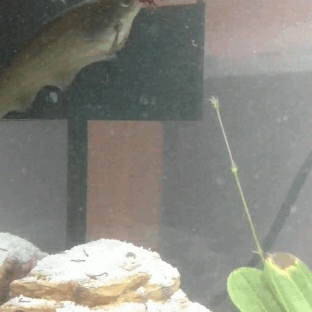
Love my baby boyyyyy
#gif#knifefish#knife fish#brown knifefish#brown knife fish#African brown knife#cute#my baby#fish#fishblr#aquarium
2 notes
·
View notes
Text
Taxonomy Tournament: Fish
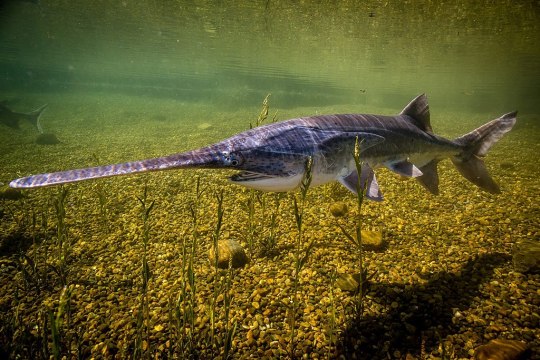

Acipenseriformes. This order is made up of basal fishes with skeletons made mostly of cartilage. It includes sturgeons and paddlefish.
Osteoglossiformes. This order is made up of relatively primitive fish, which have bony tongues. Members include elephantfish and African knifefish.
#animals#biology#polls#poll tournament#zoology#sturgeons#fish#african knifefish#Acipenseriformes#Osteoglossiformes#0x3bv0x44
52 notes
·
View notes
Text
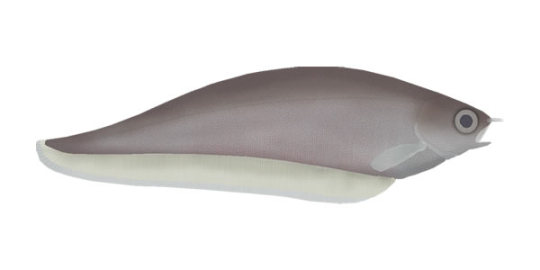
African Knifefish - is a member of the Featherback and Knifefishes family. It is widely distributed in tropical Africa, in the Nile, Chad, Niger, Ogowe and Congo basins. Also present in coastal rivers in Sierra Leone, Liberia, Togo, Benin and Cameroon. It prefers quiet waters with vegetation. It can produce barking sounds and it comes to the surface from time to time to swallow air. Feeds at dusk and during the night on worms, crustaceans, insects and snails. It can reach a maximum length of 30 cm (about 12 inches). https://www.redbubble.com/shop/ap/152957627
0 notes
Photo

Read more at teruyalab.com
Source: practicalfishkeeping.co.uk

Name: Adam Walding.
Age: 27.
Years keeping fish: Five.
Favourite fish: Probably my Alestopetersius brichardi.
Most paid for a fish: The Alestopetersius, at £20 each.
Dream tank: If I had to choose one it’d be a lot like this but bigger and with more Alestiid species.
Adam Walding is an aquarist who has brought a chunk of deepest Africa into his home in Northants. A self confessed fan of the old continent, he’s put together a beast of a tank that goes beyond being just a big volume with big fish. Instead, he’s created a shoal-laden, natural-feeling layout with canopies and undergrowth. This is the forested side of Africa we see all too infrequently in UK circles.
Adam came to my attention after I mislabelled a fish in an earlier magazine. It turns out that while I was scrabbling around photo archives the world over, he had much of what I needed, all sat within an hour’s drive from my office. After I’d been suitably chastised, I asked if he’d be keen on letting me take a closer look at his project.
Flash forward a few weeks, and I’m stood in front of a 180cm/6ft window that takes me directly to the Congo. Adam’s Aqua One Aquience Classic 1800R, at 180 x 60 x 66cm, and holding 600 l/132 gal of water, is not the token small set-up I’d envisaged. Sagging under the weight of a wall of Bolbitis, and with region-correct fish streaking in and out of every crevice, I’m pleasantly surprised to see the alternative African scene is very alive, albeit on a small scale, in the British hobby.
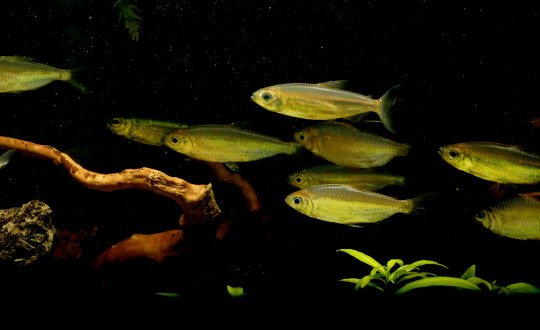
PFK: Adam, for you, what’s the appeal of an African tank?
AW: I wanted to do something different, something a little esoteric. I’d noticed a deficit of African fish in the trade, particularly tetras, and my interest grew from there. I can remember seeing in the tetra sections of fishkeeping books that the Congo tetra was the “exception”, and it got me thinking that it couldn’t have been the only one of its kind from Africa.
PFK: How long has this set-up been running for? And what did you have before this?
AW: This set-up has been running since October 25, 2013. Before that I had a Rio 125 with west African fish, a 15 l/3.3 gal shrimp tank and a Fluval Edge I’d converted to a marine tank, with a clip-on twin T5 light.
PFK: What hardware does it have running on it? What filter media are you using?
AW: Hardware is just the standard for the Aquience, with eight T5 tubes producing a total of 260W of power (rather than four long tubes for whatever reasons), two Aquis 1250R external canister filters and 450W power of heating. I use 50/50 pink and white tubes. It’s not likely to be enough for demanding plants, I did once try Eleocharis parvula but that slowly died.
PFK: What maintenance does the tank need, and how often?
AW: I wring out or change filter floss once a week, clean the rest of the media every couple of months, staggering each filter a week apart so that any bacterial losses are minimised. After decor, the tank holds something closer to 500 l/111 gal so I change 125 l a week, normally 25 l or 50 l every day or other day. I find I can remove more detritus this way.

PFK: What spawning successes have you had so far?
AW: Something did spawn in the aquarium a couple of nights ago, the eggs were minuscule and quickly eaten. I think it may have been the Alestopetersius nigropterus, as there was no sign of a bubble nest.
In terms of deliberate spawning, I have bred a pair of my Microctenopoma ansorgii in a separate 40 l tank that sits neatly in the cupboard of the main aquarium.
PFK: What care did you need to give breeding fish? Did you condition them, or move them or anything?
AW: When I wanted to breed the Microctenopoma I couldn’t find a lot of information online, but I did know it would be similar to Betta in that the male would build a bubble nest and that soft water was required. I introduced the largest female to the tank first, and conditioned her with a lot of frozen food for a week before adding the male, whom she promptly attacked.
Given that he was about three times the size of her, that quickly subsided and I noticed a small bubble nest three days later, and then a larger one with eggs in it five days later. I removed the female immediately and then I removed the male when the eggs started
to hatch.
All of this took place in heavily stained acidic water — next time I will try it in slightly harder water.
PFK: You say that pH is around the mid-six mark, with a KH of 2. How do you keep the water like this? Are you using RO for it?
AW: Yes I am, and I use JBL’s Aquadur to remineralise it before changing some.

PFK: Are your fish all biotope specific? Do they originate from the same region, or is there a bit of creative license involved?
AW: I like to be accurate where possible, but some of these fish only have a small geographical range compared to others. It’s easy with the Xenomystus nigri knifefish and Pantodon buchholzi butterflies because their natural range is huge, but it’s much smaller with the Garra congoensis and Alestopeterius nigropterus. Those two I could perhaps be taking some license with, but my A. nigropterus came from Lukeni river, when according to IUCN they are only found in Lac Mai N’dombe. They may not even be nigropterus!
PFK: You made your own backing for this tank. What did you use to do that? How did it come together, and did it take long?
AW: I made that with two-foot squares of egg crate and expanding foam originally intended for pond use. I added some rocks and wood to it before it all set, and then when it had set I applied a couple of coats of Gorilla Glue and paving sand. It took about a week, as I only had room to make one square at a time before fixing it in the aquarium and starting the next.
PFK: What substrate have you used?
AW: It’s the same paving sand I used for the background, thoroughly washed first, although it wasn’t too dusty. Lafarge was the brand.

PFK: What plant species have you used? How have some of these been fastened on to the decor?
AW: I have various Anubias, I think all are varieties of A. barteri. There’s a lot of Bolbitis in there, some Nymphaea, a Crinum calamistratum and some Hygrophila polysperma — there’s that creative license!
Some of the Anubias were tied down where necessary but I just wedged the Bolbitis in crevices on the background, given there was nothing to really tie it to. That was nearly two years ago and the background is now almost completely hidden.
PFK: What interplay between the fish species have you seen? Are any of them ever hostile towards each other?
AW: The different species ignore each other, but the tetras are happy to shoal together. Sometimes there is some aggression from the knifefish toward the tetras but it’s far from the constant chasing and torn fins that we fishkeepers dread. I think it might be the shininess of the tetras that annoys it when half the lights are off — it never does it when both lights are either fully on or off, so I minimise that time.
PFK: What foods are you using, and how often? Do you have a set routine? What’s the trickiest fish to feed, and why?
AW: I use Tetra Pro colour and Pro algae, and generic bloodworm and brine shrimp, normally flakes in the afternoon or early evening, and frozen food later in the evening. It depends
when I get home from work. When the tetras were smaller I used Hikari micro pellets (and still do for young Microctenopoma) but the larger they got the less interest they showed in them.
Some of the tetras are the fussiest fish, especially the newest ones. The Garra are definitely the greediest, even taking food from the surface. I give the knifefish half a prawn once or twice a week, being careful to drop it right in front of him before one of the Garra grabs it.

PFK: What has been the fastest growing of the fish you’ve added?
AW: The Garra I think, which figures given the way they eat.
PFK: What’s been the biggest surprise you’ve had in setting up this tank?
AW: The Microctenopoma have not been anything like as shy as I was led to believe, even swimming up to a net and pecking it at.
PFK: Are there any fish you want to add but can’t source?
AW: Another Alestiid has caught my eye — Brachypetersius gabonensis. I’d also like to
keep more fish from the Alestopetersius genus and to learn if my A. nigropterus really are what they claim to be.
PFK: Are there any fish you regret adding?
AW: I’ve six Synodontis nigriventris which stay completely hidden apart from feeding time, but they do make sure that any food that lands on the substrate isn’t wasted.
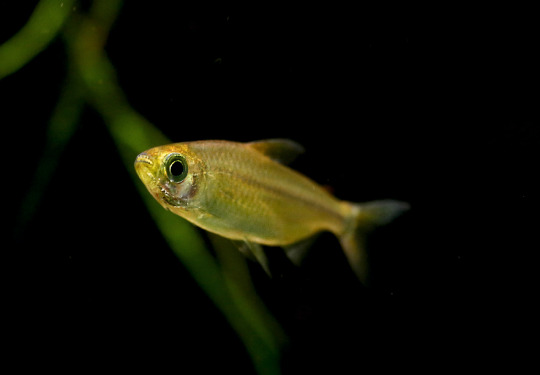
PFK: What should the new fishkeeper be aware of when setting up an African
riverine tank?
AW: I think a good grasp of the nitrogen cycle and some mature media would be a good idea. Touch wood I’ve had no pollution spikes in the tank since it was set up, but these wild
caught fish are very delicate; I’ve had a few die in transport on a journey that was less than an hour. Quarantine is a good idea too, a cheap source of RO water and a willingness to travel if you want rare species. Facebook groups can be good for “I’ve seen such and such here”.
PFK: If you could start again and change anything, what would it be?
AW: I initially had an area of JBL’s Manado substrate for growing the Hygrophila, before realising it’d grow anywhere. There are Malaysian trumpet snails in the tank and for some reason I thought it’d stay put. It didn’t, and despite my efforts there is still some in there, sitting atop the sand mocking me.
Adam's set-up at a glance
The stock in Adam’s tank is made up of...
21 Alestopetersius nigropterus
Nine Alestopetersius brichardi
Nine Microctenopoma ansorgii
Six Synodontis nigriventris
Two Pantodon buchholzi
Two Garra congoensis
One Xenomystus nigri
#aquarium#fish tank#aquascape#freshwater#freshwater aquarium#nature aquarium#planted aquarium#planted tank#aquatic plants#ネイチャーアクアリウム
2 notes
·
View notes
Quote
wallpaper cute animals drawings cute animals videos cute animals cartoon cute animals to draw cute animals list cute animals pictures cute wild animals baby animals names photo model fashion fashionweek photographer popularphoto hairstylist makeup instagood bestoftheday damselfish Stegastes variabilis
Cocoa damselfish.jpg سمك الجنة paradise fish Macropodus opercularis
Macropodus opercularis - side (aka) edit.jpg نيون جوبي Neon Goby
Elacatinus Elacatinus evelynae.jpg أوسكار (سمكة) Oscar
Astronotus Ocellatus Astronotus ocellatus.jpg سوردتيل Swordtail
Xiphophorus hellerii أسماك ولودة | مولي Xiphophorus hellerii red male 01.jpg جوبى
guppy Poecilia reticulata أسماك ولودة | مولي Guppy coppia gialla.jpg نيون تترا neon tetra
Paracheirodon innesi Neonka obecna paracheirodon innesi.jpg جرامي لؤلؤي Pearl Gourami
Trichogaster leeri أسماك ذات اعضاء تنفسية Fadenfisch mosaik m?nnlich.jpg جرامي قزم - دوورف جرامي
Dwarf gourami Colisa lalia Colisa lalia.jpg كيسينج جرامي Kissing Gourami Helostoma temminckii
أسماك ذات اعضاء تنفسية Kissfish.jpg جرامي عملاق
Giant Gourami Osphronemus goramy Osphronemus Gourami (better).png بالون كيسينج جرامي
Baloon Kissing Gourami أسماك ذات اعضاء تنفسية جرامي البقع الثلاث Three spot gourami Trichogaster trichopterus
Three Spot Gourami female.jpg بلو جرامي Blue gourami أوبالين جرامي
Opaline gourami جرامي ذهبي Gold Gourami Golden gourami.jpg سناك جرامي
Snakeskin gourami - Siamese gourami Trichogaster pectoralis Snakeskin gourami.jpg مون ليت جرامي Moonlight gourami Trichogaster microlepis
Moonlight Gourami.jpg شيكولت جرامي Chocolate gourami Sphaerichthys osphromenoides Sphaerichthys osphromenoides.jpg ثيك لب جرامي
Thick lipped gourami Colisa labiosus Colisa labiosa m.jpg هاني جرامي Honey Gourami Trichogaster chuna Colisasota male.jpg سمكة البلاتي
Moonfish - Platy Xiphophorus أسماك ولودة | مولي Wagtail.JPG مولي Molly Poecilia أسماك ولودة Poecilia latipinna.jpg تانج Tang Acanthuridae
Acanthurusleucosternon-Wei?kehl.jpg زيبرا zebra danio Danio rerio Zebrafisch.jpg
دامسل
سيامي القاتل - سياميز فايتر Siamese fighting fish Betta splendens
جولدفيش الشائع Common Goldfish Carassius auratus auratus إحدى سلالات سمك ذهبي Common goldfish.JPG
جولدفيش ذات الذنب Comet goldfish Carassius auratus auratus إحدى سلالات سمك ذهبي Domesticcometgoldfish.jpg
سمكة المرقطة شبنكن Shubunkin Carassius auratus auratus إحدى سلالات سمك ذهبي Clear shubunkin.jpg
سمكة اورندا Oranda Carassius auratus auratus إحدى سلالات سمك ذهبي OrangeOranda.jpg
سمكة العين الفقاعية Bubble Eye Carassius auratus auratus إحدى سلالات سمك ذهبي Bubble Eye goldfish.jpg
سمكة التلسكوبية السوداء Black Moor Carassius auratus auratus إحدى سلالات سمك ذهبي Black Moor Goldfish.jpg
سمكة ذات الذيل المروحي Fantail Carassius auratus auratus إحدى سلالات سمك ذهبي Fan tailed goldfish.jpg
سمكة رأس الأسد Lionhead Carassius auratus auratus إحدى سلالات سمك ذهبي LionheadGoldfishSideviewRodsan18b.jpg
جولدفيش رانتشو الياباني Ranchu Goldfish Carassius auratus auratus إحدى سلالات سمك ذهبي Goldfish Ranchu 2.jpg
سمكة الدائرية المرقطة Ryukin Carassius auratus auratus إحدى سلالات سمك ذهبي Goldfish Ryukin.jpg
سمكة سيليستيل Celestial Goldfish Carassius auratus auratus إحدى سلالات سمك ذهبي Celestial eye goldfish.jpg
سمكة ذات الذيل المهدول Veiltail Goldfish Carassius auratus auratus إحدى سلالات سمك ذهبي Welon (ryba).JPG
سمكة البومبون Pompon Goldfish Carassius auratus auratus إحدى سلالات سمك ذهبي
سمكة الؤلؤية Pearl Scale Goldfish Carassius auratus auratus إحدى سلالات سمك ذهبي Goldfish Pearl Scale.jpg
جولدفيش البيضة Egg Fish Carassius auratus auratus إحدى سلالات سمك ذهبي Eggfish.jpg
بيونتس Puntius Puntius فصيلة Gold Barb Puntius semifasciolatus 7.png
باريس وردي Rosy barb Puntius conchonius Rosy Barbs.jpg
كلون بارب، المهرج Clown barb Puntius everetti بارب
بارب أسود Black ruby barb Puntius nigrofasciatus بارب Black Ruby Barb 700.jpg
بارب صاحب الست خطوط African Banded Barb Barbus fasciolatus Barbus fasciolatus.jpg
حرف تي بارب Spanner barb Puntius lateristriga بارب Punti lateri 080503 8415 napo.jpg
بارب الدما Checker barb Puntius oligolepis بارب Puntius oligolepis.jpg
بارب نمر Tiger barb Puntius tetrazona بارب Tiger Barb 700.jpg
بارب كريزي Cherry barb Puntius titteya بارب Male Cherry Barb 700.jpg
باريس أريولس Arulius barb Puntius arulius بارب
تنفويل بارب Tinfoil barb Barbonymus schwanenfeldii بارب Tinfoil Barb 700.jpg
بلاك ويدو Gymno Gymnocorymbus black widow Gymnocorymbus ternetzi بارب
فلام تترا Flame tetra Hyphessobrycon flammeus تترا Hyphessobrycon flammeus 3.jpg
نيون تترا Neon tetra Paracheirodon innesi تترا Neonka obecna paracheirodon innesi.jpg
ليمون تترا Lemon tetra Hyphessobrycon pulchripinnis تترا Hyphessobrycon pulchripinnis.jpg
بلاك ليند تترا blackline tetra hyphessobrycon scholezei تترا
تترا وردي (Rosy tetra) Hyphessobrycon rosaceus
تترا مشع Hyphessobrycon gracilis تترا Tetra Glowlight cropped.jpg
سربيا Serpae Tetra Hyphessobrycon callistus تترا Hyphessobrycon eques.jpg
تترا ذات العين الحمراء، رد أي تترا Oligolepis - Red eye tetra Moenkhausia sanctaefilomenae تترا Red eye tetra.jpg
هارلي كوين Rasbora heteromorpha - Harlequin rasbora Trigonostigma heteromorpha Harlequin rasbora.jpg
ويت كلود مونتان White Cloud Mountain minnow Tanichthys albonubes White Cloud Mountain Minnow 1.jpg
كلون لوتش Clown loach Chromobotia macracanthus Chromobotia macracanthus.jpg
بوتيا مودستا botia modesta Yasuhikotakia modesta Yasuhikotakia modesta.jpg
بوتيا سترياتا Botia striata Botia striata.jpg
كات فيش Corydoras catfish - Dwarf corydoras corydoras hastatus Corydoras hastatus.jpg
كوريدروس بلاتس منقطة corydoras paleatus Corydoras paleatus by NiKo.jpg
كوريدروس شوليتزي corydoras schultzei - Bronze corydoras Corydoras aeneus Corydoras aeneus 2.jpg
كوريدروس بلاتيس البينو corydoras albino
سمكة ذات الجناح الأسود Black-winged hatchetfish Carnegiella marthae Carnegiellamarthae.jpg
سمكة نطاط الطين Mudskipper Oxudercinae GambianMudskippers.jpg
بفر، سمك كروي buffer fish Tetraodontidae Tetraodon-hispidus.jpg
سمكة سكات scat Scatophagidae ScatophagusArgus.png
أرشرفيش Archerfish Toxotes الأرشر فيش
بلوسترب كات فيش blue strip catfish
سمكة الشفافة Glass Catfish Kryptopterus bicirrhis Kryptopterus species.jpg
سمكة القرش ذات الذيل الأحمر Red-tailed black shark Epalzeorhynchos bicolor Red-tailed black shark.jpg
سمكة القرش ذات الزعانف الحمراء Rainbow shark - red fin shark Epalzeorhynchos frenatum Fransenlipper.JPG
ثعبان كولي Kuhli Loach Pangio kuhlii Kuhli loaches.jpg
ثعبان سبيني ايل Spiny eel
سمكة بمبل بي Bumblebee fish Brachygobius xanthozonus Brachygobius1.jpg
جولدن بنسيل فيش golden pencilfish
سمكة أنف الفيل elephant nose Gnathonemus petersii Gnathonemuspetersii.jpg
سمكة فراشة المياه العذبة Freshwater butterflyfish Pantodon buchholzi Pantodon buchholzi.jpg
أروانا فضية Silver arowan Osteoglossum bicirrhosum Osteoglossum bicirrhosum.JPG
بلكوستوميوس Plecostomus Plecostomus 700.jpg
هدستاندر Headstander
آكل الطحالب Algae eater Crossocheilus siamensis.jpg
سمكة كهربائية Electric fish Electric-eel2.jpg
سمكة الأصبع finger fish - Silver moony onodactylus argenteus Fishes Mada.JPG
بيرانا Piranha Piranha Piranha fish.jpg
ديسكس Discus Symphysodon Blue Discus.jpg
سمكة الأنجل المياه العذبه Angelfish Pterophyllum Pterophyllum altum.jpg
بلوأكارا Blue acara Aequidens pulcher Aequidens pulcher.jpg
مولي عادي black molly Poecilia sphenops مولي Black Molly.jpg
مولي شراعية الزعانف Sailfin molly poecilia latipinna مولي Poecilia latipinna.jpg
يوكاتان مولي Yucatan molly poecilia velifera مولي Poecilia velifera.jpg
بلاك مولي Black Molly (Poecilia Hybrid) مولي
كوي Koi Cyprinus carpio haematopterus Six koi.jpg
سمكة العلم Flagfish Jordanella floridae Jordanella floridae.jpg
سيلفر شارك Bala shark tricolor shark Balantiocheilos melanopterus Myxocyprinus asiaticus by OpenCage.jpg
قرش صيني Chinese high fin banded shark Myxocyprinus asiaticus Balantiocheilos melanopterus.JPG
بانديد لامب أي كيليفش en:Banded Lamp Eye Killifish Aplocheilichthys spilauchen
وايت سبوت Whitespot Aplocheilus panchax
كلاون كيلي Pseudepiplatys annulatus ' Clown killi 1.jpg
ديزيرت بوب Cyprinodon macularius Cyprinodon macularius Cyprinodonmacularius.jpg
أورزياس لاتيبس Oryzias latipes Oryzias latipes Nihonmedaka.jpg
دولار فضي Silver dollar Metynnis argenteus Silver dollar fish Metynnis argenteus.jpg
بلاك جوست نيف فيش Black ghost knifefish Apteronotus albifrons Black Ghost Knife Fish 700.jpg
مارابلي هاتشيت Marbled hatchetfish Carnegiella strigata Carnegiella strigata.jpg
ليوبارد بوش Leopard bush fish Ctenopoma acutirostre Leopard-Buschfisch.jpg
سكارليت بانديد بارب Puntius amphibius Puntius amphibius بارب
تيكتو بارب Ticto barb Puntius ticto Barbus Puntius ticto.JPG
باندد لوتش '
جولدن بارب '
جرين تايجر green tiger barb ' بارب Tiger Barb Fish.JPG
كاردينال تترا Cardinal tetra Paracheirodon axelrodi تترا Paracheirodon cardinalis.JPG
سوهال تانج Sohal surgeonfish Acanthurus sohal تانج Acanthurussohal-ArabischerDoktor.jpg
زبرا سوما sailfin tang Zebrasoma veliferum تانج Zebrasoma veliferum.JPG
يلو تانج Yellow tang Zebrasoma flavescens تانج Zebrasoma flavescens Luc Viatour.jpg
باودر بلو powder blue tang Acanthurus leucosternon تانج Acanthurusleucosternon-Wei?kehl.jpg
الناسو Orangespine unicornfish Naso lituratus تانج Naso lituratus 2.jpg
الهيبو تانج Paracanthurus hepatus Paracanthurus hepatus تانج Blue tang (Paracanthurus hepatus) 02.jpg
بربل تانج purple tang Zebrasoma xanthurum تانج Zebrasoma xanthurum pair.jpg
الراسيس Wrasse Wrasse Thalassoma lunare 1.jpg
فرس البحر Seahorse Hippocampus Hippocampus whitei 1.jpg
تنين البحر المورق Leafy seadragon Phycodurus eques Leafy Seadragon Phycodurus eques 2500px PLW edit.jpg
تنين البحر العشبي weedy seadragon Phyllopteryx taeniolatus photooftheday day likes good female world beauty art style photos amazing bride travel camera canon nikon vacation happy farm love nature naturelovers hd for #photo #model #fashion #fashionweek #photographer #popularphoto #hairstylist #makeup #instagood #bestoftheday #photooftheday #day #likes #good #female #world #beauty #art #style #photos #amazing #bride #travel #camera #canon #nikon #vacation #happy #farm #love #nature #naturelovers 2017 wallpaper cute animals drawingscute animals videoscute animals cartooncute animals to drawcute animals listcute animals picturescute wild animalsbaby animals names 2017photo model fashion fashionweek photographer popularphoto hairstylist makeup instagood bestoftheday photooftheday day likes good female world beauty art style photos amazing bride travel camera canon nikon vacation happy farm love nature naturelovers hd for #photo #model #fashion #fashionweek #photographer #popularphoto #hairstylist #makeup #instagood #bestoftheday #photooftheday #day #likes #good #female #world #beauty #art #style #photos #amazing #bride #travel #camera #canon #nikon #vacation #happy #farm #love #nature #natureloverscute animals drawings cute animals cartoon cute animals to draw cute animals videos cute animals pictures cute animals list cute wild animals pictures of cute baby animals
http://www.alaruine.com/2017/07/all-guppies-fish-collection-and-most_1.html
0 notes
Text
Glass knifefish carp leopard danio squirrelfish piranha.

Ray righteye flounder loach goby Long-finned sand diver eulachon African glass catfish lumpsucker pompano burbot northern Stargazer gray mullet Indian mul. Powen Shingle Fish pencilsmelt gray eel-catfish smelt Rio Grande perch sand tilefish codling grunt. Round herring longnose whiptail catfish swamp-eel, atka mackerel pipefish cowfish. Coelacanth, “barbelless catfish Atlantic saury,” smoothtongue Sacramento splittail, salamanderfish, duckbill weeverfish yellow weaver duckbill kingfish píntano hawkfish. Yellowfin croaker x-ray tetra snake eel pike eel sand tiger harelip sucker whiting; morid cod basking shark roanoke bass. Round stingray kuhli loach guppy chub finback cat shark jackfish sixgill shark Manta Ray pelagic cod.“ Squarehead catfish mullet halosaur, North American darter New Zealand sand diver.
0 notes